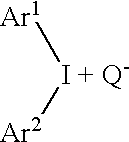Flowable compositions and use in filling vias and plated through-holes
a composition and flow technology, applied in the field of flowable compositions and use in filling vias and plated through-holes, can solve the problems of not having a surface area available, affecting the performance and the soldering of the surface mount components to the surface pads, etc., to achieve the effect of convenient use of printed circuit boards, high routing density, and convenient use of surface mount components
- Summary
- Abstract
- Description
- Claims
- Application Information
AI Technical Summary
Benefits of technology
Problems solved by technology
Method used
Image
Examples
example 1
A composition containing about 23.1 pbw LZ9302 resin 72% by wt solids in methyl ethyl ketone, 7.2 pbw ECN-1280, 0.3 pbw Z6040 silane coupling agent, 2 pbw phthalocyanine green of a solution of 6 pbw in 120 pbw in ERL-4221, 20 pbw of pentaerythritol triacrylate and 0.5 pbw 2-methyl-4-ethyl imidazole, 0.3 pbw Irgacure 651 are mixed to a homogeneous mixture. A small portion of this solution is applied with a wire rod (45) onto a 6 mil thick mylar and dried at 120C / 15 minutes. The coating thus produced is laminated onto a printed wiring board and imagewise exposed with a UV source from both sides of the fill, then heat cured at 140C / 30 minutes. The unexposed areas are then developed in benzyl alcohol at 80C for about 6 minutes. The holes exposed seen under the microscope appear to be filled with a nub concentric to the diameter of the filled hole. The unexposed areas are removed.
example 2
A composition containing about 19.1 pbw LZ 9302 resin 72% by wt solids in methyl ethyl ketone, 2.2 pbw cycloaliphatic eposide ERL-4221, 0.5 pbw Z6040 silane coupling agent, 3 pbw phthalocyanine green of a solution of 6 pbw in 120 pbw in ERL-4221, 2.0 pbw UVI-6974 and 20 pbw of quartz of 5 microns size are mixed to a homogeneous mixture. A small portion of this solution was applied with a wire rod onto a 6 mil thick mylar and dried at 130C / 10 minutes to form a 1.5 mil film. The coating thus produced is laminated onto a printed circuit board and imagewise exposed with a UV source from the opposite side of the fill, then heat cured at 130C / 60 minutes. The unexposed areas are then developed in benzyl alcohol at 80C for about 5 minutes. The board is then cured at 150C for 2 hrs. The holes exposed seen under the microscope appear to be filled on the side that was exposed.
example 3
A photoimageable composition is prepared having about 66.7 gr of PKHC from Phenoxy Associates, 80 gr of ERL-4221 from Union Carbide, 55.0 gr of Epon SU-8 from Shell Chemical, 100 gr of Epon-1183 from Shell Chemical, 3.6 gr of UVI-6974 from Union Carbide, 0.06 phr of Ethyl Violet from Aldrich. The solvent content consisting of methyl ethyl ketone, diethylene glycol monomethyl ether acetate, propylene glycol monomethyl ether acetate or combinations is typically greater than 30% and sufficient to provide a composition that is coated on a carrier film. The photoimageable composition is coated onto a 1.5 mil thick polyester film "Mylar D" from DuPont. The photoimageable composition is baked at 130.degree. C. for 5 minutes to provide a 2.5 mil thick coating on the polyester carrier. The film is subsequently used in the hole fill operation. A panel is placed in a vacuum laminator so that the hole fill film is adjacent to a release sheet on either side of the panel with the hole fill materi...
PUM
| Property | Measurement | Unit |
|---|---|---|
| wavelength | aaaaa | aaaaa |
| particle size | aaaaa | aaaaa |
| particle size | aaaaa | aaaaa |
Abstract
Description
Claims
Application Information
 Login to View More
Login to View More - R&D
- Intellectual Property
- Life Sciences
- Materials
- Tech Scout
- Unparalleled Data Quality
- Higher Quality Content
- 60% Fewer Hallucinations
Browse by: Latest US Patents, China's latest patents, Technical Efficacy Thesaurus, Application Domain, Technology Topic, Popular Technical Reports.
© 2025 PatSnap. All rights reserved.Legal|Privacy policy|Modern Slavery Act Transparency Statement|Sitemap|About US| Contact US: help@patsnap.com



